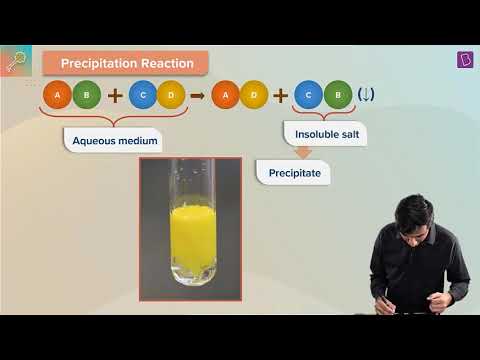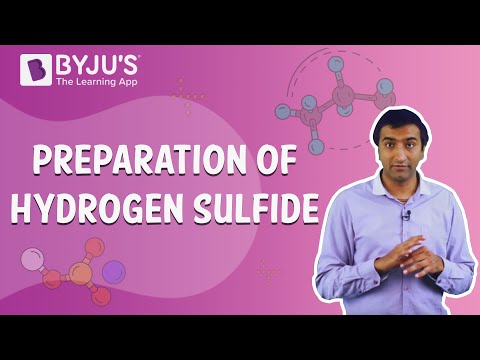Chemical reactions involve chemical changes that result in the formation of new compounds under some specific conditions. Chemical equations can help us understand the chemical reactions between various elements or compounds. Chemical equations show the reactants and the products that are involved in these reactions. The compounds that participate in a chemical reaction are called reactants. The reactants might be in the solid, gaseous, or liquid phase.
Table of Contents
What is Precipitation Reaction?
Many chemical reactions occur in our daily lives. Common examples of such reactions are burning, corrosion, cooking of food and digestion. One important class of chemical reactions are precipitation reactions. In such reactions, two different soluble salts (which are in aqueous solutions) combine to form two products. One of these products is insoluble in the solution and is precipitated out (and is, therefore, referred to as the ‘precipitate’).
Precipitation Reaction – Definition and Meaning
The term ‘precipitation reaction’ can be defined as “ a chemical reaction occurring in an aqueous solution where two ionic bonds combine, resulting in the formation of an insoluble salt”. These insoluble salts formed in precipitation reactions are called precipitates. Precipitation reactions are usually double displacement reactions involving the production of a solid form residue called the precipitate. These reactions also occur when two or more solutions with different salts are combined, resulting in the formation of insoluble salts that precipitate out of the solution.
One of the best examples of precipitation reactions is the chemical reaction between potassium chloride and silver nitrate, in which solid silver chloride is precipitated out. This is the insoluble salt formed as a product of the precipitation reaction. The chemical equation for this precipitation reaction is provided below.
AgNO3(aqueous) + KCl(aqueous) —–AgCl(precipitate) + KNO3(aqueous)
In the above reaction, a white precipitate called silver chloride or AgCl is formed which is in the solid-state. This solid silver chloride is insoluble in water. Precipitation reactions help in determining the presence of different ions present in a particular solution.
The other example of a precipitation reaction is the reaction between calcium chloride and potassium hydroxide, resulting in the formation of an insoluble salt Called calcium hydroxide. The chemical equation for this reaction is below-
2KOH(aqueous) + CaCl2(aqueous)—-Ca(OH)2(aqueous) + 2KCl(aqueous)
Some more examples of chemical equations of on precipitation reaction are as below-
AgNO3(aqueous) + NaCl(aqueous) —- AgCl↓ + NaNO3 (aqueous)
Mg(OH)2(s) + 2HCl (aqueous) ——— MgCl2(aqueous) + 2H2O(l)
Properties of Precipitates and Precipitation Reaction
Some of the properties of precipitates and the reaction are as below-
- The precipitation reaction undergoes in aqueous solutions or medium in an ionic state.
- The reaction takes place between ions present in the aqueous solutions, forming the product
- The products formed at the end of precipitation reaction are the precipitates which are insoluble in aqueous solutions
- Precipitation reactions are known as ionic reactions since the ions actively take part in the reaction and form the product.
- These reactions depend on the temperature, concentration of the solution, buffer solution, etc.
Applications Of Precipitation Reaction
Precipitation reaction helps in determining a particular element present in the given solution. These reactions also monitor the formation of a precipitate when some chemical is added to solutions. These are used for the extraction of magnesium from the seawater. The human body also encounters these reactions existing between antigens and antibodies.
Examples Of Precipitation Reaction In Everyday Life
Precipitation reaction can be used in wastewater treatment. When a contaminant forms an insoluble solid, then we can use this reaction to precipitate out the contaminated ions. In wastewater, a frequent presence of heavy metals can be found such as compounds of sulphide and hydroxide. So, we can add a source of hydroxide that is soluble (NaOH Or Na2S) that will result in a precipitation reaction.
Recommended Videos
Chemical Reactions and Equations

Preparation of Hydrogen Sulfide

Frequently Asked Questions – FAQs
Why do precipitation reactions occur?
When a solution containing a particular cation (a positively charged ion) is combined with another solution containing a certain anion (a negatively charged ion), the formation of an insoluble compound can often occur. A precipitate is considered the solid that divides.
Is precipitation a sign of a chemical reaction?
The formation of a precipitate also suggests the presence of a chemical reaction. When a silver nitrate solution is poured into a sodium chloride solution, a chemical reaction occurs, producing a white silver chloride precipitate.
What is an example of formation of precipitate?
When a silver nitrate solution is poured into a sodium chloride solution, a chemical reaction occurs, producing a white silver chloride precipitate. A yellow lead(II) iodide precipitate is formed when the potassium iodide solution reacts with the lead(II) nitrate solution.
Is Salt a precipitate?
The insoluble salt falling out of the solution is referred to as the precipitate, hence the name of the reaction. Precipitation reactions in the solution can help determine the identity of different ions.
What factors affect precipitation?
Prevailing waves, the presence of mountains, and seasonal waves are the 3 major factors that influence precipitation. Mountain ranges are a series of mountains interconnected by high soil. Where precipitation occurs, a mountain range in the direction of prevailing winds can also determine.

It has helped me a lot
thanks chris!
would dilute hydrochloric acid react with sodium thiosulphate be a precipitation reaction?
Yes. Sodium thiosulphate, when reacted with dilute acid, produces sulphur dioxide, water, and sulphur. The sulphur formed is insoluble and usually forms a white or pale yellow precipitate.
Thank u so much. It helped me a lot.
This information has really helped me and I could not thank you enough for your hard work.
thanks for helping us
Why 2KOH(aqueous) + CaCl2(aqueous)—-Ca(OH)2(aqueous) + 2KCl(aqueous) is a ppt reaction althogh no any ppt formed?
2KOH(aqueous) + CaCl2(aqueous) —→ Ca(OH)2(aqueous) + 2KCl(aqueous)
Resulting in the formation of an insoluble salt called calcium hydroxide.
Is silver chloride which is formed by adding siver and chlorine a precipitate
Silver chloride is easily prepared by combining aqueous solutions of silver nitrate and sodium chloride and also be produced by reacting silver nitrate with cobalt(II) chloride.
AgNO3 + NaCl –> AgCl + NaNO3
2AgNO3 + CoCl2 –> 2AgCl + Co(NO3)2
It helped a lot! Thank you so much
what is insoluble salt means?
Insoluble salts are ionic compounds that are insoluble in water: the salt continues to exist as a solid rather than dissolving in the liquid.